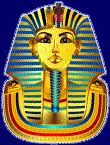
The Land & The Nile
| The First Egyptians | Hieroglyphics and Mathematics |
| The Pyramids | The Sphinx |
| Gods and Goddesses | The Afterlife |
| Tutankhamen | Home |

| The First Egyptians | Hieroglyphics and Mathematics |
| The Pyramids | The Sphinx |
| Gods and Goddesses | The Afterlife |
| Tutankhamen | Home |
The river Nile, apart from being the longest river in the world, is also the most important river in the world, according to the ancient Egyptians. Every year the Nile flooded (and still does), at almost exactly the same time of year, 15th July. In Aswan it would rise about 10 metres while in Delta it was much less. Apart from supplying water to the Egyptians, the Nile was most important because it covered the sandy fields in thick mud in which Egyptians grew their food. They called this the ‘Black Land’ with the barren desert further beyond known as the ‘Red Land’.
The Nile was both the Egyptians friend and foe. If it rose too much it would sweep away their houses, and destroy their crops reducing the amount of food left to feed everyone.
In the marshes lotus flowers were picked to make perfume, vegetables and ducks were gathered for food, and papyrus was collected to make boats, paper, rope, sandals and many different baskets.
The Nile also provided a great means of transport. People would row or drift up the Nile and it’s canals in their boats, which were made of wood if they were large, or papyrus if they were smaller.
Egyptians could move great stone blocks in their boats, which is a popular idea of how huge stone rocks, were transported to the pyramids.